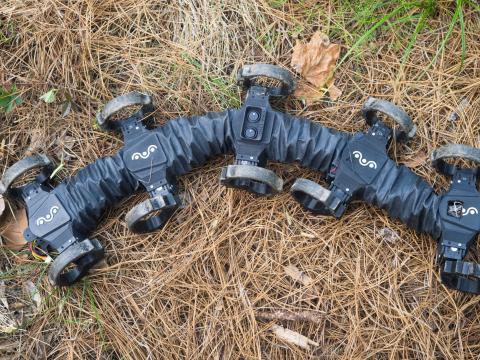Quantum Radar Could Render Stealth Aircraft Obsolete
An international research team has developed a laboratory prototype of a quantum radar that has the potential to detect objects invisible to conventional systems while using very low-energy transmissions. The technology may improve the detection of multimillion-dollar stealth aircraft and the ability to spot cancerous cells noninvasively.
“Potentially, they could make stealth aircraft obsolete, but not now—only in the long term. Quantum technologies are still at the early stage of their development,” says Stefano Pirandola, an associate professor with the University of York’s department of computer science and the York Centre for Quantum Technologies in the United Kingdom. Pirandola, who led the research team, estimates that it could take at least 15 years before a quantum radar system is fielded.
Quantum technology may prove especially useful in scenarios too difficult for conventional systems. A conventional radar antenna emits a microwave signal to scan a region of space. Any target object reflects the signal to the source, but objects of low reflectivity immersed in regions with high background noise are hard to spot using classical systems. “The [target] object itself can be almost invisible, with very low reflectivity and using signals that are faint—using just a few photons,” Pirandola offers. “It is a very extreme situation where quantum illumination aims to detect low-reflectivity objects in very noisy backgrounds using faint signals.”
The new breed of radar is a hybrid system that combines electro-optical and mechanical properties with quantum physics. It uses quantum entanglement between invisible microwave beams and visible light beams to detect hard-to-spot objects.
At the heart of the new technology is a special converter adopted by the research team, which includes scientists from Canada, Germany, Italy, the United Kingdom and the United States. The converter has a cavity on the left for microwave photons and a cavity on the right for optical photons. In the middle is a vibrating mechanical oscillator, which can be a metallized membrane or a piezoelectric crystal. The oscillator can be used to entangle microwave and optical photons at the quantum level, which, in the words of Albert Einstein, is where things get spooky.
When two photons are entangled, whatever changes are made to one are made to the other, no matter how far apart they are. If one smacks into an enemy aircraft, the other suffers the same effects. “The vibration of this membrane in the middle of these two cavities can be engineered in such a way to create a coupling between the microwave and optical photons,” Pirandola explains. “This coupling allows you to convert optical to microwave. The quantum state of the optical photons can be transferred to the microwave photons and vice versa. It is a new thing—a very important development—because it allows you to generate entanglement in microwave beams.”
Once the photons are coupled, the microwaves are transmitted as a probe beam, while the visible photons remain, acting as an idler beam. “If the probe bounces off the target and returns to the device, a second electro-optomechanical device converts it to a visible light beam, which is then allowed to interfere with the idler,” Pirandola adds.
If a target is present, the beam reflects off of it and back to the detector, where it interferes with the idler beam. “Even if the entanglement between the two beams is broken up by noise in the environment, some residual correlations remain that affect the interference so that probe photons can be distinguished from photons coming from the thermal background. This makes it possible to identify reflections from the target even when the signal is very weak,” Pirandola elaborates.
In layman’s terms, the radar keeps one entangled photon and transmits the other toward the target. That photon returns to the radar along with the “noise” generated by the environment. “When the transmitted photon comes back, you are able to identify that because it is correlated. Even if it is mixed with many other photons, that is the only one that will interfere with the [correlated] photon that you kept,” he states.
The quantum radar is rooted in research Pirandola participated in while working at the Massachusetts Institute of Technology in 2009. “I contributed to the development of an optical method, called quantum illumination, which aimed to improve the detection of targets by means of quantum entanglement. However, the method was developed only for the optical wavelengths, while the most natural regime is clearly the microwaves,” he recalls. “Thanks to advances in optomechanics and the development of efficient microwave-optical converters, we are now able to apply this method to the microwave regime, which is why we can call it a quantum radar.”
One reason the technology will not hit the field soon is that single-photon detectors for optical frequencies are well-developed, but that is not yet the case for microwave detectors. “The problem is that we want to work with microwaves, but we don’t have detectors that are very efficient. Our technique needs detectors that are very good at working at the quantum level—let’s say, a single-photon level,” Pirandola says. “We want to use this device in microwaves for scanning the object, but then we want to use the optical regime for doing the measurements. It’s really the interface between the two regimes that is very important.”
In addition, using current technology results in a loss or degradation of the idler photons over time. Ideally, the radar will use quantum memory technology, which is not yet mature. “This loss problem can limit the range of the radar to something like 15 or 20 kilometers potentially, but when one is able to fix this problem using quantum memory, we can expand the range to much more,” Pirandola predicts.
Integrating other technologies, such as tracking devices, also will present a challenge. “In the case of the stealth aircraft, you want to see the reflection far from a potential object in the sky, but also, you would like to include tracking systems, like a Doppler analysis, because the object could be moving, so you may have a Doppler effect,” he says.
Another drawback of quantum systems is that they require extreme cold, or cryogenic temperatures, to operate. Cryogenic temperatures are somewhere in the neighborhood of minus 238 Fahrenheit. “It’s not a big problem in the lab, of course. But this means the radar should have some sort of refrigerator available. I don’t know how that will affect the size and the shape [of a fielded system],” Pirandola offers.
Because the quantum radar operates at much lower energies than conventional systems, it has long-term potential for a range of applications in biomedicine. “Low energy means noninvasive. And noninvasiveness is the key point for this biomedical application,” Pirandola says.
Such a noninvasive property is particularly important for short-range biomedical applications, he says. In the long term, the technology could be operated at short distances to detect the presence of defects in biological samples or human tissues thanks to the low number of quantum-correlated photons. The method could be used to develop noninvasive nuclear magnetic resonance spectroscopy of fragile proteins and nucleic acids and potentially could be applied to MRIs, with the aim of reducing the radiation dose absorbed by patients.
A medical device would use the same principle as a stealth-busting radar, but it would be modified and adopted for short distances. For example, a system may work in transmission and not in reflection, and would work at longer wavelengths below 1 gigahertz.
Pirandola’s research was funded by the Leverhulme Trust and the Engineering and Physical Sciences Research Council. The research is published in Physical Review Letters.





Comment
Not a B-2 "Spirit", but, rather, the F-35 "Lightning II"
The image of an aircraft featured in this article, and earlier, on the pre-Masthead, while perhaps flying over Whiteman AFB Missouri, is certainly NOT a B-2 "Spirit", AKA "Stealth Bomber". Rather, the image is of the F-35 "Lightning II", which, coincidentally, also contains "Stealth" technology. Interesting references to Einstein's "spooky action at a distance" and quantum entanglement.
Thank you for your feedback!
Comments